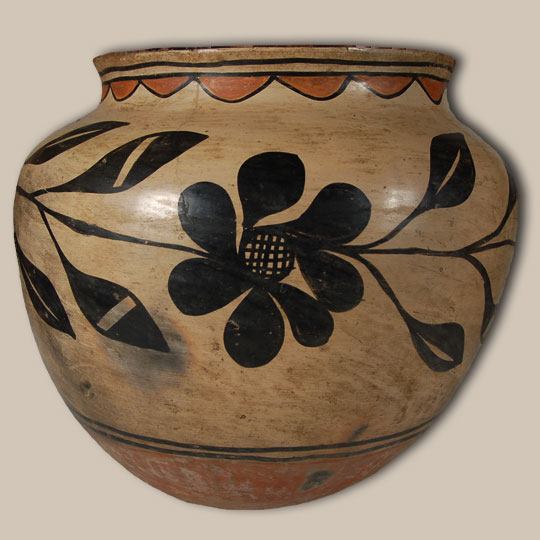Adobe Gallery Blog
Subject: Kewa Pueblo Polychrome Storage Jar
This storage jar was formed of native clay with typical crystalline rock temper. The underbody was not slipped but the natural tan clay of the vessel was stone-polished to a hard finish and the Kewa Pueblo distinctive large red band of rough polish, striated, soapy-like appearance was added below the design band. This is indicative of a post-1880 date.
The bottom of the vessel is flat as is traditional with storage jars, unlike water jars that have a concave underbody. The neck interior was slipped first in bentonite slip then red slip was rag-wiped over the bentonite leaving a quarter-inch of bentonite visible. The rim top is black (a post-1800 characteristic). There is significant evidence of use. The rag-wiped bentonite slip is a wonderfully warm cream/off-white color, with subtle fire clouding and superb patina.
The entire body was designated for the design panel without a division separating the neck area from the body. The large floral vegetal black design is typically Kewa Pueblo in origin with certain boldness and seemingly deliberate execution—a sure mark and fantastic sense of space and design. A series of semicircular elements, suggestive of clouds, are suspended from one of the two framing lines around the neck. A second pair of framing lines encircles the vessel body at the base of the design. All four framing lines feature ceremonial breaks.
This is a fantastic example of a Kewa Pueblo Polychrome jar with excellent patina, a warm/subtle glow to the white slip, and beautifully executed vegetal-black design elements.
Condition: There were several insignificant line cracks which have been repaired and an area of exfoliation due to water overflow that has been left in the natural state with no attempt to over-paint. This is a true find for the collector of the finest quality historic pueblo pottery from circa 1890-1910.
Provenance: from the collection of a Phoenix ranching family.
Recommended Reading: A River Apart: The Pottery of Cochiti and Santo Domingo Pueblos by Valerie K Verzuh


